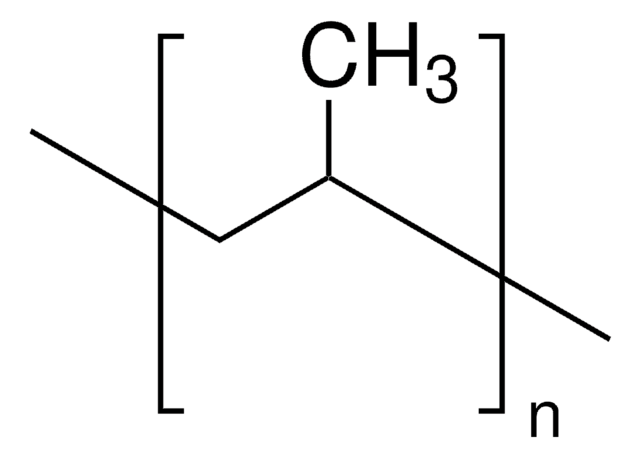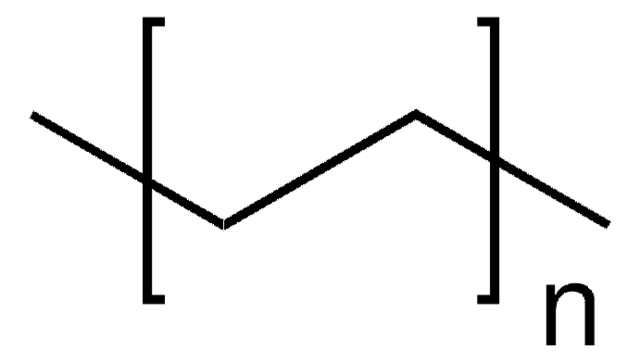All Photos(2)
About This Item
Linear Formula:
[CH2CH(CH3)]n
CAS Number:
MDL number:
UNSPSC Code:
12162002
PubChem Substance ID:
NACRES:
NA.23
Recommended Products
Quality Level
form
pellets
hardness
18 dmm (Penetrometer, ASTM D 5)
viscosity
10 poise(190 °C, Brookfield Thermosel)(lit.)
transition temp
Tg -10 °C
softening point 155 °C (ring and ball, ASTM E 28)
density
0.9 g/mL at 25 °C (lit.)
SMILES string
CC=C
InChI
1S/C22H42O3/c1-2-3-4-5-11-14-17-20-21(25-20)18-15-12-9-7-6-8-10-13-16-19-22(23)24/h20-21H,2-19H2,1H3,(H,23,24)/t20-,21+/m1/s1
InChI key
NSYDMBURIUSUDH-RTWAWAEBSA-N
Looking for similar products? Visit Product Comparison Guide
Application
Base polymer in hot melt adhesives and paper-laminating, extender and viscosity modifier in caulks and sealants and waterproofing agent in wire and cable applications.
Features and Benefits
Low odor, good heat stability, low color and broad compatibility with elastomers, plastics and tackifying resins.
Storage Class Code
11 - Combustible Solids
WGK
WGK 3
Flash Point(F)
Not applicable
Flash Point(C)
Not applicable
Personal Protective Equipment
dust mask type N95 (US), Eyeshields, Gloves
Choose from one of the most recent versions:
Already Own This Product?
Find documentation for the products that you have recently purchased in the Document Library.
F Cassiola et al.
Artificial organs, 24(3), 168-173 (2000-04-12)
The introduction of microporous polypropylene hollow fibers in recent years has brought considerable advances to blood oxygenators. However, lifetime and assembly problems are still unresolved. In this work we tried to rate the oxygen permeation velocity by turning the fibers
[Procedure for membrane oxygenation of blood over hydrophilic polymer membranes].
H Körber et al.
Biomedizinische Technik. Biomedical engineering, 43 Suppl, 338-340 (1998-12-22)
Simon J Gallagher et al.
Journal of drug targeting, 11(6), 373-379 (2003-12-12)
The aim of this study was to test the hypothesis that the most appropriate model for studying the diffusional release of an active from a topical formulation is one in which the membrane offers minimal resistance to release and involves
G Imanidis et al.
European journal of pharmaceutics and biopharmaceutics : official journal of Arbeitsgemeinschaft fur Pharmazeutische Verfahrenstechnik e.V, 47(3), 283-287 (1999-06-26)
The possibility to control the release rate of salbutamol through the hydrophobic Celgard 2500 polypropylene membrane by varying the composition and the viscosity of hydrophilic drug vehicles was investigated. The use of the polypropylene membrane as a control membrane for
P K Amid et al.
Journal of biomedical materials research, 28(3), 373-375 (1994-03-01)
This preliminary study examined the possibility of preventing intestinal adhesions to biomaterials while preserving their incorporation with the abdominal wall. White New Zealand rabbits received intraperitoneal implants of different biomaterials for repair of defects created on the abdominal wall. The
Our team of scientists has experience in all areas of research including Life Science, Material Science, Chemical Synthesis, Chromatography, Analytical and many others.
Contact Technical Service



